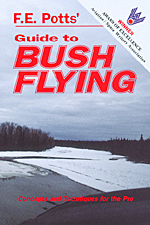Section I: Equipment and Environment
Part II, Chapter 5: Spring
After the long cold winter finally comes spring, with its steadily increasing daylight hours, rising temperatures, wind, wet snow, low cloud decks, icing conditions, and beautiful calm sunny days (see illustration 2 for an example of spring sun bathing, Alaska style).
Steam fog
Steam fog, which posed intermittent problems during the winter, can be a daily problem along the Arctic Coast during this time as the pack ice begins to draw away from shore.
Since this fog is generally local in nature, with tops around 1,200 feet AGL, and rarely comes further inland than a few miles (unless there's an offshore wind), alternate airports to consider might include village strips, gravel bars, and other areas where you could land within radio range of your destination to wait for the weather to rise above IFR minimums, or, for VFR pilots coming in from the bush, to turn VFR.
Snow
The occasional wet heavy snowfalls you had to deal with during winter chinooks are common during this period, and you will have to take the same precautions now as you did then.
Snow squalls
Snow squalls will occur, sometimes turning into freezing rain. Passes will be blocked, and patience once again will be much in demand.
Icing conditions
Cloud decks will be low with temperatures close to freezing at ground level, and ice will become a problem. Instruments will not be the cure-all they were during winter, and, like the VFR pilot, you too will have to exercise patience.
Beautiful calm sunny days
Call in "well" and take a day off with the family. The boss won't expect you to fly when it's nice; after all, aren't the hard jobs in tough weather always reserved for you?
